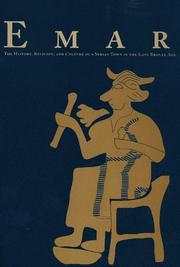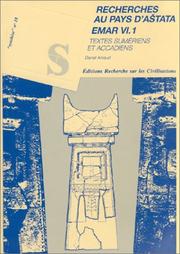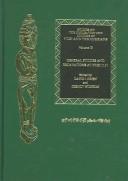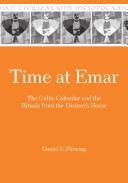| Listing 1 - 10 of 17 | << page >> |
Sort by
|
Book
ISBN: 9004429115 Year: 2020 Publisher: Leiden, Netherlands : Brill,
Abstract | Keywords | Export | Availability | Bookmark
 Loading...
Loading...Choose an application
- Reference Manager
- EndNote
- RefWorks (Direct export to RefWorks)
In The Politics of Ritual Change: The zukru Festival in the Political History of Late Bronze Age Emar, John Thames explores the intersection of ritual and politics in ancient Syria. The cuneiform texts describing an elaborate festival called zukru invite the reader to consider the development of the ritual as a result of political influence. This book suggests a new understanding of the relationship between the Hittite Empire and the city of Emar that is best observed through religious texts. The Harvard Semitic Monographs series publishes volumes from the Harvard Museum of the Ancient Near East. Other series offered by Brill that publish volumes from the Museum include Harvard Semitic Studies and Studies in the Archaeology and History of the Levant, https://hmane.harvard.edu/publications.
Book
ISBN: 2865380440 Year: 1982 Publisher: Paris Recherche sur les civilisations
Abstract | Keywords | Export | Availability | Bookmark
 Loading...
Loading...Choose an application
- Reference Manager
- EndNote
- RefWorks (Direct export to RefWorks)
Bronze age --- -Civilization --- Emar (Extinct city) --- Syria --- Emar (Ancient city) --- Maskanah Site (Syria) --- Meskéné Site (Syria) --- Antiquities. --- Antiquities --- -Emar (Extinct city) --- Emar (Extinct city). --- Civilization
Book
ISBN: 9782503533209 2503533205 Year: 2010 Publisher: Turnhout, Belgium : Brepols,
Abstract | Keywords | Export | Availability | Bookmark
 Loading...
Loading...Choose an application
- Reference Manager
- EndNote
- RefWorks (Direct export to RefWorks)
Excavations (Archaeology) --- Emar (Extinct city) --- Syria --- Antiquities. --- History. --- Civilization. --- History

ISBN: 1883053188 Year: 1996 Publisher: BETHESDA : CDL Press,
Abstract | Keywords | Export | Availability | Bookmark
 Loading...
Loading...Choose an application
- Reference Manager
- EndNote
- RefWorks (Direct export to RefWorks)
Bronze age --- Emar (Extinct city) --- Emar (Extinct city). --- Civilization --- Emar (Ancient city) --- Maskanah Site (Syria) --- Meskéné Site (Syria) --- Syria --- Antiquities
Book
ISBN: 2865381374 2865381382 9782865381388 9782865381371 Year: 1986 Volume: 18 Publisher: Paris Recherche sur les civilisations
Abstract | Keywords | Export | Availability | Bookmark
 Loading...
Loading...Choose an application
- Reference Manager
- EndNote
- RefWorks (Direct export to RefWorks)
Emar (Extinct city) --- -Emar (Extinct city) --- Emar (Ancient city) --- Maskanah Site (Syria) --- Meskéné Site (Syria) --- Excavations (Archaeology) --- Syria --- Antiquities. --- Antiquities --- Excavations (Archaeology) - Syria
Book
ISBN: 9789004369658 Year: 1992 Publisher: Atlanta, Ga. : Scholars Press.
Abstract | Keywords | Export | Availability | Bookmark
 Loading...
Loading...Choose an application
- Reference Manager
- EndNote
- RefWorks (Direct export to RefWorks)
Baal (Canaanite deity) --- Women priests --- Akkadian language --- Cult --- Emar (Extinct city) --- Syria --- Syria. --- Religion.

ISBN: 2865381781 Year: 1985 Volume: 6.4 28 Publisher: Paris : Recherche sur les civilisations,
Abstract | Keywords | Export | Availability | Bookmark
 Loading...
Loading...Choose an application
- Reference Manager
- EndNote
- RefWorks (Direct export to RefWorks)
Cuneiform inscriptions --- Inscriptions cunéiformes --- Emar (Extinct city) --- Emar (Ville ancienne) --- Inscriptions cunéiformes --- Akkadian language --- Sumerian language --- Akkadien (Langue) --- Sumérien (Langue) --- Texts --- Textes

ISBN: 1883053757 9781883053758 Year: 2003 Volume: 13 Publisher: BETHESDA : CDL Press,
Abstract | Keywords | Export | Availability | Bookmark
 Loading...
Loading...Choose an application
- Reference Manager
- EndNote
- RefWorks (Direct export to RefWorks)
Cuneiform tablets --- Names, Personal --- Emar (Extinct city) --- Anthroponomy --- Baby names --- Christian names --- Family names --- Forenames --- Names of families --- Names of persons --- Personal names --- Surnames --- Names --- Onomastics --- Tablets, Cuneiform --- Clay tablets --- Cuneiform writing --- Emar (Ancient city) --- Maskanah Site (Syria) --- Meskéné Site (Syria) --- Syria --- Antiquities --- Cuneiform tablets - Iraq - Emar (Extinct city) --- Names, Personal - Middle East

ISBN: 1575065223 9781575065229 1575060442 9781575060446 1575060442 9781575060446 Year: 2000 Publisher: Winona Lake, Ind. Eisenbrauns
Abstract | Keywords | Export | Availability | Bookmark
 Loading...
Loading...Choose an application
- Reference Manager
- EndNote
- RefWorks (Direct export to RefWorks)
The recent large-scale watershed projects in northern Syria, where the ancient city of Emar was located, have brought this area to light, thanks to salvage operation excavations before the area was submerged. Excavations at Meskeneh-Qadimeh on the great bend of the Euphrates River revealed this large town, which had been built in the late 14th century and then destroyed violently at the beginning of the 12th, at the end of the Bronze Age. In the town of Emar, ritual tablets were discovered in a temple that are demonstrated to have been recorded by the supervisor of the local cult, who was called the “diviner.” This religious leader also operated a significant writing center, which focused on both administering local ritual and fostering competence in Mesopotamian lore. An archaic local calendar can be distinguished from other calendars in use at Emar, both foreign and local. A second, overlapping calendar emanated from the palace and represented a rising political force in some tension with rooted local institutions. The archaic local calendar can be partially reconstructed from one ritual text that outlines the rites performed during a period of six months.The main public rite of Emar’s religious calendar was the zukru festival. This event was celebrated in a simplified annual ritual and in a more elaborate version of the ritual for seven days during every seventh year, probably serving as a pledge of loyalty to the chief god, Dagan. The Emar ritual calendar was native, in spite of various levels of outside influence, and thus offers important evidence for ancient Syrian culture. These texts are thus important for ancient Near Eastern cultic and ritual studies. Fleming’s comprehensive study lays the basic groundwork for all future study of the ritual and makes a major contribution to the study of ancient Syria.
Rites and ceremonies --- Religious calendars --- Calendar, Religious --- Calendars, Religious --- Church calendar --- Ritual calendars --- Calendar --- Ceremonies --- Cult --- Cultus --- Ecclesiastical rites and ceremonies --- Religious ceremonies --- Religious rites --- Rites of passage --- Traditions --- Ritualism --- Manners and customs --- Mysteries, Religious --- Ritual --- Emar (Extinct city) --- Emar (Ancient city) --- Maskanah Site (Syria) --- Meskéné Site (Syria) --- Syria --- Religion. --- Antiquities --- HISTORY / Ancient / General. --- Emar (Extinct city).
Book
ISBN: 9042909099 9789042909090 Year: 2001 Volume: 8 Publisher: Leuven : Editions Peeters,
Abstract | Keywords | Export | Availability | Bookmark
 Loading...
Loading...Choose an application
- Reference Manager
- EndNote
- RefWorks (Direct export to RefWorks)
Late Hittite Emar examines the economic and juridical texts from ancient Emar (modern Tell Meskene-Qadime) with a basically threefold task in view. The first is to discern the chronological span of the texts, and then using the political information of the texts to correlate the kings of Emar with the known kings of Karkemish in the thirteenth century B.C. The conclusion is that Emar fell to invaders considerably earlier than most have supposed to date. The second task looks at various aspects of Emar's social history, in particular whether the ilku-system operated there as at Ugarit, and more than thirty texts which attest both sale of family members and real estate "in a time of distress" (i.e. famine). It appears that Emar was left largely to run its own affairs under the Hittite aegis. Meanwhile, two leading families at Emar largely controlled the traffic in humanity, one being the entrenched clan of diviner-priests. The final section examines the attestation of Emar in earlier texts, from Ebla to Idri-mi, and concludes that there was no previous history of kingship at Emar. A text from the palace corpus which mentions an attempted coup d'État against one of the Emarite kings receives close analysis, while the final chapter attempts an identification of the possible agents of Emar's destruction, with a particular focus on Aramaean activity in the region.
Age du bronze --- Bronstijd --- Hettieten --- Hittites --- Syrie --- Syrië --- Extinct cities --- Kings and rulers --- Social life and customs --- Emar (Extinct city) --- Syria --- Antiquities --- Bronze age --- -Civilization --- -Emar (Extinct city) --- -Emar (Ancient city) --- Maskanah Site (Syria) --- Meskéné Site (Syria) --- Politics and government --- -Sources --- Social conditions --- -Politics and government --- Civilization --- Emar (Ancient city) --- Sources --- Sources. --- Extinct cities - Syria --- Hittites - Kings and rulers --- Hittites - Social life and customs --- Syria - Antiquities
| Listing 1 - 10 of 17 | << page >> |
Sort by
|

 Search
Search Feedback
Feedback About
About Help
Help News
News